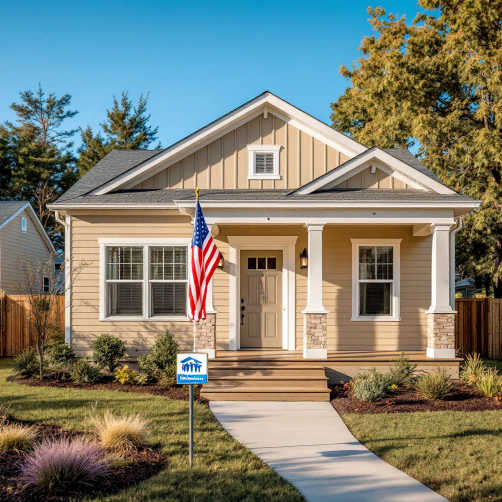Owning a home is a dream for many, but it feels out of reach for some. Habitat for Humanity bridges this gap by offering affordable homeownership opportunities to needy families. However, suppose you’re considering applying for or already living in a Habitat for Humanity house. In that case, you might wonder: how long you have to live in a Habitat for Humanity house?
Understanding Habitat for Humanity Homeownership
What Is Habitat for Humanity?
Habitat for Humanity is a global nonprofit organization that builds affordable housing for needy families. Founded in 1976, the organization aims to eliminate poverty, housing, and homelessness by bringing people together to build homes, communities, and hope. Unlike traditional charity programs, Habitat emphasizes partnership and involvement.
One of Habitat for Humanity’s unique aspects is its concept of “sweat equity.” Future homeowners are required to actively participate in building their homes or other Habitat projects. This collaborative process fosters a sense of pride, ownership, and connection with the community.
How Does the Homeownership Program Work?
The Habitat for Humanity homeownership program isn’t a giveaway—it’s a structured, affordable housing opportunity. Here’s how the program typically works:
- Sweat Equity: Homebuyers contribute time and effort by volunteering on construction projects or attending workshops.
- Affordable Mortgages: Homes are sold to families at no profit and are financed with affordable mortgage payments.
- Community Involvement: Future homeowners often work alongside volunteers and staff, creating a shared purpose.
By blending affordability, education, and community, Habitat for Humanity ensures that families own homes and thrive in them.
Eligibility and Initial Requirements
Who Can Apply?
Habitat for Humanity homes are designed for families who meet specific eligibility criteria. These criteria may vary slightly based on location, but the general requirements include:
You may also read (house with the red chimney)
- Income Limits: Applicants must fall within a specific income range, typically between 30% and 80% of the area’s median income (AMI). This ensures the program supports families who need affordable housing solutions.
- Need for Housing: Applicants must demonstrate a genuine need for housing. This could include living in overcrowded spaces, unsafe conditions, or paying unaffordable rent.
- First-Time Homebuyer Status: While not always required, some affiliates prioritize first-time homebuyers.
Key Steps to Qualify
To qualify for a Habitat for Humanity home, applicants must complete several steps:
- Documentation: Provide proof of income, residency, and other financial details.
- Homebuyer Education: Attend mandatory budgeting, home maintenance, and financial literacy workshops.
- Savings and Credit: While perfect credit isn’t necessary, demonstrating financial readiness is essential.
These steps ensure that homeowners are prepared to move in and equipped to maintain long-term stability.
The Homeownership Journey: From Application to Move-In
The Application Process
Applying for a Habitat home involves several stages:
- Please submit an Application: Applicants fill out a detailed form providing information about their financial situation and housing needs.
- Interviews: Qualified candidates are interviewed to assess their commitment and alignment with Habitat’s mission.
- Approval: If selected, families are notified, and the next steps in the process are begun.
This process can take several months, so patience is key.
Sweat Equity and Education
Sweat equity is a cornerstone of the Habitat for Humanity program. Homebuyers are required to contribute a specific number of hours to the program, which may include:
- Building their own home or other Habitat homes.
- Attending educational workshops.
- Volunteering with Habitat projects.
These activities reduce costs and prepare homeowners for the responsibilities of owning a property.
Closing and Moving In
Once all requirements are met, the final steps include signing the mortgage agreement and receiving the keys. Moving into a Habitat home is a moment of pride and accomplishment for families who’ve worked hard to achieve stability.
How Long Do You Have to Live in a Habitat for Humanity House?
Is There a Minimum Residency Requirement?
One of the most common questions is whether there’s a minimum amount of time you must live in a Habitat home. The answer varies depending on the affiliate, but in most cases, homeowners must live in the house as their primary residence for the duration of the mortgage. This could range from 15 to 30 years, depending on the terms.
Many affiliates also include a minimum residency period, often between 1 to 5 years, to prevent house flipping and encourage community stability.
Mortgage Terms and Ownership
It’s important to understand that Habitat homes are sold, not gifted. Homeowners sign a legal agreement to repay an affordable mortgage. These contracts often include clauses restricting the sale or rental of the property during the loan term.
What Happens If You Need to Move?
Life happens, and circumstances can change. If you need to move before paying off the mortgage, here’s what typically happens:
- Selling the Home: You may be required to sell the home back to Habitat for Humanity or follow specific resale guidelines.
- Violating Residency Terms: Moving out prematurely or renting the home could result in consequences, such as financial penalties or legal action.
These policies ensure that Habitat’s mission of providing affordable housing remains intact.
Life as a Habitat for Humanity Homeowner
Responsibilities After Move-In
As a Habitat homeowner, your responsibilities don’t end after moving in. You’ll need to:
- Keep up with mortgage payments.
- Maintain the property to ensure it remains in good condition.
- Stay involved in your community, often through volunteer work or local events.
Benefits of Long-Term Residency
Living in a Habitat for Humanity home offers numerous benefits, including:
- Building Equity: You’ll own more of your home over time, creating financial security.
- Community Connections: Many Habitat communities are close-knit and supportive.
- Stability: Long-term residency provides a stable environment for families to thrive.
You may also read (repossession of my house)

